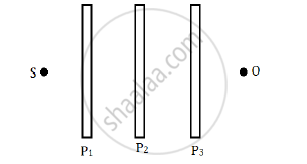Advertisements
Advertisements
प्रश्न
Which of the following properties shows that light is a transverse wave?
विकल्प
Reflection
Interference
Diffraction
Polarization
उत्तर
Polarization
Reflection, interference and diffraction are the phenomena shown by both transverse waves and longitudinal waves. Polarization is the phenomenon shown only by transverse waves.
APPEARS IN
संबंधित प्रश्न
If the polarising angle for a given medium is 60°, then the refractive index of the medium is.................
What is a Polaroid?
Draw a neat labelled diagram showing the plane of vibration and plane of polarisation for polarised light.
Three identical polaroid sheets P1, P2 and P3 are oriented so that the pass axis of P2 and P3 are inclined at angles of 60° and 90° respectively with the pass axis of P1. A monochromatic source S of unpolarised light of intensity I0 is kept in front of the polaroid sheet P1 as shown in the figure. Determine the intensities of light as observed by the observer at O, when polaroid P3 is rotated with respect to P2 at angles θ = 30° and 60°.

Using the phenomenon of polarisation, show how the transverse nature of light can be demonstrated.
The glass plate of refractive index 1.732 is to be used as a polarizer, its polarising angle is _______.
Unpolarised light is incident on a polaroid. How would the intensity of transmitted light change when the polaroid is rotated?
A beam of light is incident at the polarizing angle of 35° on a certain glass plate. The refractive index of the glass plate is :
Green light is incident at the polarising angle on a certain transparent medium. The angle of refraction is 30° . Find
(i) polarising angle, and
(ii) refractive index of the medium.
Light transmitted by Nicol prism is ______.
What is a polariser?
State and obtain Malus’ law.
State Brewster’s law.
What is double refraction?
Mention the types of optically active crystals with example.
How is polarisation of light obtained by scattering of light?
Which of the following phenomena is not common to sound and light waves?
For the same objective, find the ratio of the least separation between two points to be distinguished by a microscope for light of 5000 Å and electrons accelerated through 100 V used as the illuminating substance.
To ensure almost 100 per cent transmissivity, photographic lenses are often coated with a thin layer of dielectric material. The refractive index of this material is intermediated between that of air and glass (which makes the optical element of the lens). A typically used dielectric film is MgF2 (n = 1.38). What should the thickness of the film be so that at the center of the visible spectrum (5500 Å) there is maximum transmission.
An unpolarized light beam is incident on the polarizer of a polarization experiment and the intensity of light beam emerging from the analyzer is measured as 100 Lumens. Now, if the analyzer is rotated around the horizontal axis (direction of light) by 30° in clockwise direction, the intensity of emerging light will be ______ Lumens.
